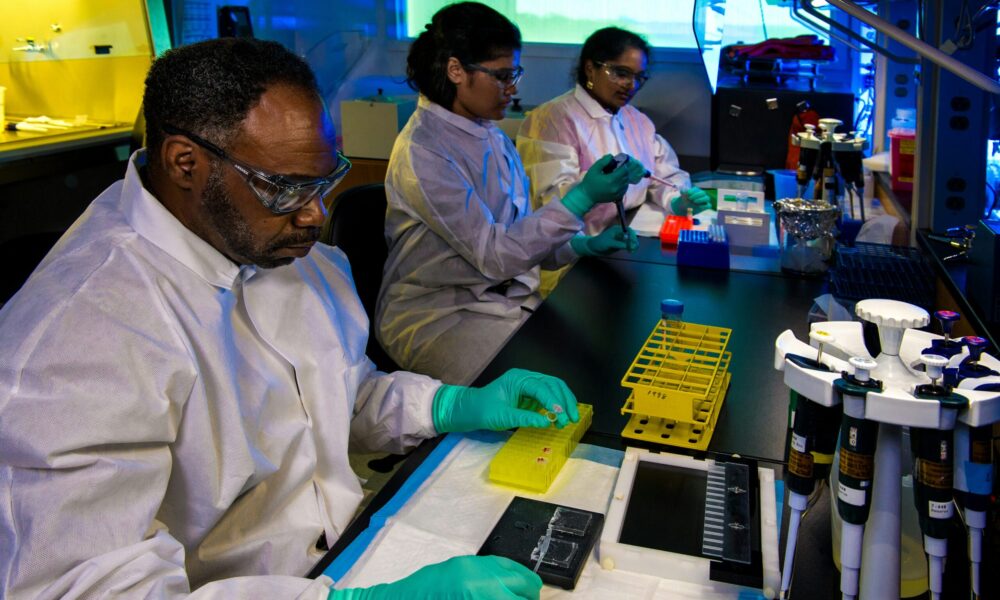On May 23, as the country headed into Memorial Day weekend, President Trump signed an Executive Order (EO) misleadingly titled Restoring Gold Standard Science. Putting the phrase “gold standard” in front of anything may lead a reader to believe that the subject is expected to be of the highest possible quality. But this EO is another smoke screen created by the Trump administration in order to push its political agenda disguised as science.
If this feels familiar, it should: the Trump administration is repeatedly using the same playbook to methodically dismantle the role of science in policy and decision making.
In this EO, the Trump administration is using terms associated with science and scientific inquiry—like “transparency” and “reproducibility”—to create the illusion of support for federal science. This is all happening against the broader backdrop of its anti-science actions, like cutting scientific funding and laying off thousands of federal scientists.
This EO also seeks to roll back existing scientific integrity policies in federal agencies to what they were before President Trump left the White House after his first term. This will effectively weaken protections against political interference in federal science.
By silencing and sidelining science, the administration is positioning itself as an arbiter of truth—all to push policy that meets its political goals and rewards powerful, connected interests, even as it endangers the health and safety of everyone in the US. They’re targeting scientific integrity protections and exploiting the language of transparency to exclude whatever scientific evidence they find inconvenient. This EO is another brick in the wall that the Trump administration is building between the benefits of science-driven policy and real people.
What is scientific integrity, and why does it matter?
In lay terms, the goal of scientific integrity is to protect the validity of science and the scientific process by creating safeguards against political interference. More specifically, SI policies aim to:
- Keep ideological and corporate interests, like industry polluters and political lobbyists, out of the scientific process,
- Make federal scientific evidence and research publicly accessible while protecting personally identifiable information (PII) of people involved in research as participants,
- Protect federal scientists from being censored or intimidated from communicating their research to the public, and
- Use the best available science, or “the most reliable, valid, up-to-date, and relevant, empirical knowledge on any given topic” in federal decision and policy making.
The Scientific Integrity Act would codify these types of protections into law, ensuring safeguards against political interference and intimidation of federal scientists are consistent across federal agencies.
When these standards are undercut—like when political officials interfere in federal science—it’s considered a scientific integrity violation. It’s not a new phenomenon in the federal government; studies show examples of political interference in science starting in the 1950s. In fact, UCS has been speaking out about scientific integrity violations and tracking related attacks on science for almost two decades. During the first Trump administration, we tracked over 200 attacks on science in four years, amounting to more attacks on science than the previous two administrations combined—an unprecedented pace. Now, we’re seeing more potential attacks occurring in the five months since President Trump’s second inauguration.
After the chaos of President Trump’s first term, the following administration made efforts to strengthen scientific safeguards in the executive branch. A federal task force—which consisted of a team of scientific integrity experts from across agencies—reviewed all existing scientific evidence on SI policies and their effectiveness. Based on their review, the Office of Science and Technology Policy (OSTP) created a set of resources and recommendations that federal agencies were instructed to follow to strengthen their SI policies. This set of resources was developed with feedback from 30 federal agencies and over 1,000 individuals and organizations.
As a result, many federal agencies created mechanisms to more easily report scientific integrity violations and protect federal scientists from influence and retaliation. In some cases, this was some agencies’ first version of their own SI policies. These advancements and changes in SI policies helped professionalize and normalize scientific integrity. By extension, they set a standard for enforcing safeguards against political interference. The latest EO signed by President Trump calls to undo all this progress, leaving federal agencies with a weakened or completely absent SI policy.
What’s being demanded here is an unwinding of scientific integrity policies, under the misleading name of “Gold Standard Science,” to serve the values and priorities of the current administration. This development is alarming for multiple reasons, many of which stem from how much we all benefit from the existence and enforcement of agency scientific integrity policies.
Weakening scientific integrity policies and protections will hurt everyone. It will negate the role that the best available science should play in crafting public policy—impacting how chemicals can be regulated, vaccines can be tested, and weather can be tracked. It will hurt the federal workers who conduct the scientific research and analysis, it will endanger the environment, and it will disproportionately harm children and communities overburdened by cumulative impacts, including low-income communities and communities of color.
Red flags flying
In the EO signed on Friday, President Trump uses phrases that are commonly associated with the scientific community and attempts to position the administration as an advocate for the scientific process. That’s far from the truth—proven by its systemic attack on the American scientific enterprise—and the EO is full of red flags.
First: the EO justifies these rollbacks of scientific integrity policies by citing the public’s distrust in science. Although the public’s trust in science fluctuates over time, most Americans consistently trust science and believe scientists act in the public’s best interest. Indeed, the White House’s messaging about science undermines this trust and confidence.
Second: although the EO uses terms like reproducibility, transparency, unbiased peer-review, and falsifiability, one key pillar of scientific research is missing: independence. Scientists need to conduct their work independently to ensure that the conclusions they reach and communicate to policymakers and members of the public are free from interference.
Imagine, for example, if a federal research study found that a certain chemical released from burning fossil fuels is harmful to the environment and to public health. Protecting the independence of science, as federal agency SI policies are meant to do, would prevent fossil fuel companies and their allies in the administration from trying to bury or alter the results of the study, or prevent the scientists involved in this work from communicating their findings outside of the federal agency.
Third: because President Trump is calling for federal agencies to roll back their SI policies to what they were before the end of his first term, that means there will be little to no process in place for federal workers to report potential SI violations. The EO instead calls for internal processes to be established within agencies that involve oversight from political appointees and human resource employees. There are multiple reasons for concern around this change alone.
It’s very unlikely that either of these parties have expertise in scientific integrity; the scientific and technical expertise of political appointees is far less certain than their loyalty to the President. And as I explained earlier, the main goal of SI policies is to protect science and the scientific process from political interference. It’s counterintuitive to place a political appointee in charge of enforcing scientific integrity policies and resolving violations when the supposed main purpose of this EO and its subsequent actions is to take politics out of science. This could increase scientists’ fear of retaliation and deter them from reporting violations, for one, and make it easier for federal science to be politicized without consequence.
A benefit to polluters—at our expense
Scientific research and its conclusions are not always convenient for political appointees and corporate interests. There are actors who advocate for decreased regulation of dangerous chemicals, who spread disinformation about vaccine safety and effectiveness, and who diminish the harm of fossil fuel production and use.
These interests—following a playbook pioneered by the tobacco industry and frequently used by fossil fuel companies—try to limit what scientific evidence federal agencies can consider. In part, the EO calls for any future scientific study that is used to inform policy to make their scientific analysis and modeling available to the public.
Public health studies often rely on anonymized personal health information from hospitals and doctors, but the details of that information are kept private for good reason, at no expense to the potential for reproducibility. These kinds of studies are vital for understanding the impacts of, for example, air pollution on children’s respiratory health, and need to be considered in making policies.
Exploiting the rhetoric of “transparency,” powerful and well-connected interests have tried to discredit these studies. When robust scientific research like this is excluded from consideration, it creates a gap that conspiracy theorists and self-interested industry representatives can fill in.
Removing and weakening existing SI agency policies will create a playground for polluters, conspiracy theorists (including those in the presidential cabinet), and ideologues to more easily push for policy that would advance their political agenda—and enable them to wield that power at the expense of the rest of us, especially vulnerable groups who are disproportionately impacted by weak or nonexistent public health and safety rules.
What’s next
There are two key points on the timeline set out by this EO. It requests the Director of the OSTP to issue guidance for agencies to incorporate the values of what the White House calls “Gold Standard Science” before the end of June. Federal agencies then have until the end of July to report back to the OSTP Director on how they are following the new standards. In the meantime, federal agencies have been directed to rescind and revise any policies created during the previous presidential administration—all of which resulted in the strongest SI policies in federal agencies to date.
We’ll continue to follow how things unfold. We must monitor how agencies respond to this order and ensure that scientific integrity and science-based decision making are preserved across agency actions, including rulemaking and scientific assessments. If you’re interested in learning more about how we can work together to combat attacks on science and scientific integrity, register for our SI Webinar taking place on June 5th.

